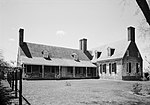Chesapeake Beach railway station
1898 establishments in Maryland1979 establishments in MarylandFormer railway stations in MarylandMuseums established in 1979Museums in Calvert County, Maryland ... and 5 more
National Register of Historic Places in Calvert County, MarylandRailroad museums in MarylandRailway stations in the United States opened in 1898Railway stations on the National Register of Historic Places in MarylandTransportation buildings and structures in Calvert County, Maryland

The Chesapeake Beach railway station is a historic railway station located at Chesapeake Beach, Calvert County, Maryland, United States. It is composed of two one-story, hip-roofed sections; one part was once an open passenger boarding area that was later enclosed for storage. The station was erected in 1898, for the Chesapeake Beach Railway. It is now operated as a railway museum. The Chesapeake Beach Railway Station was listed on the National Register of Historic Places in 1980.
Excerpt from the Wikipedia article Chesapeake Beach railway station (License: CC BY-SA 3.0, Authors, Images).Chesapeake Beach railway station
C Street,
Geographical coordinates (GPS) Address Nearby Places Show on map
Geographical coordinates (GPS)
| Latitude | Longitude |
|---|---|
| N 38.69 ° | E -76.534166666667 ° |
Address
C Street
20732
Maryland, United States
Open on Google Maps






